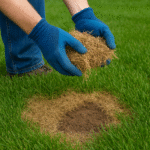How to Fix Brown Spots in Your Lawn: Colorado Homeowner’s Guide
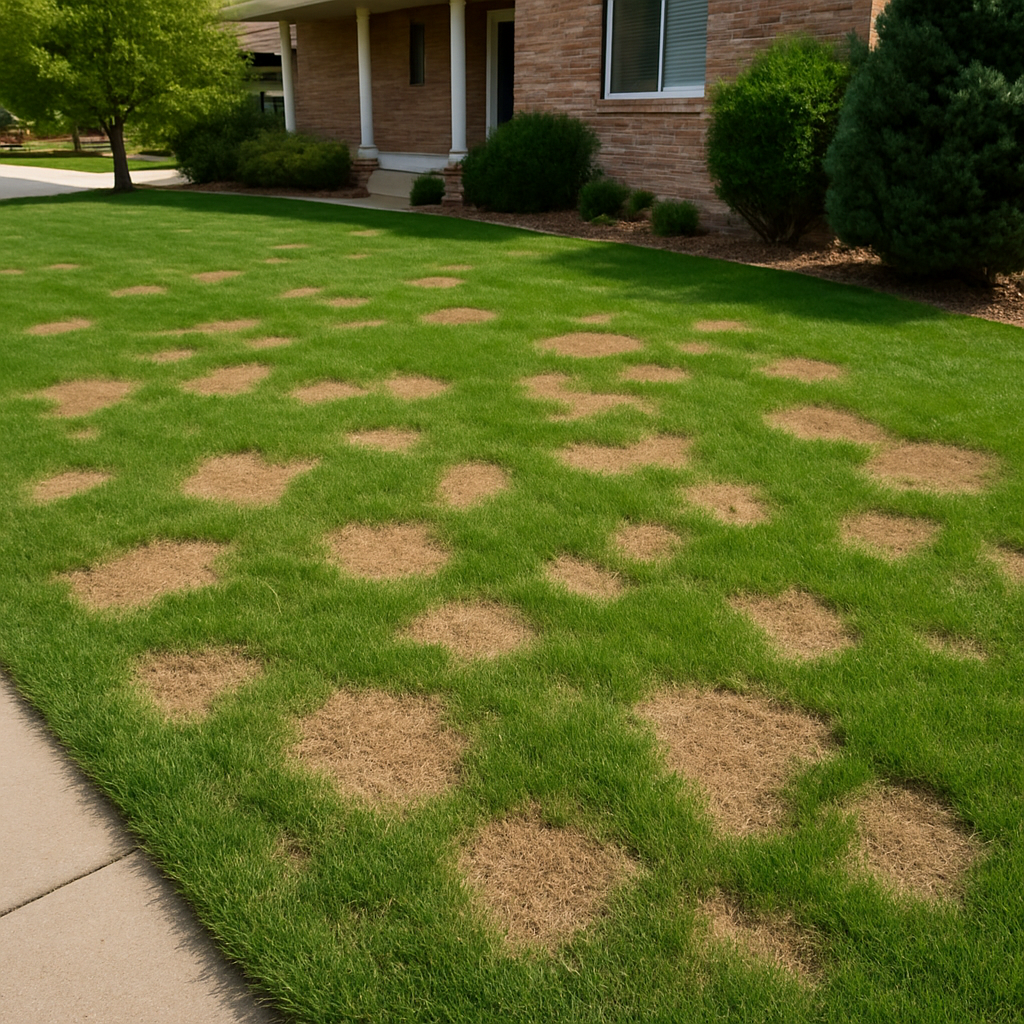
If you’ve ever looked out at your yard and noticed ugly brown patches creeping across your once-lush grass, you’re not alone. Brown spots in lawns are one of the most common frustrations for Colorado homeowners — and the good news is, they’re fixable!
In this guide, we’ll break down exactly how to fix brown spots in your lawn, why they happen (especially in Colorado’s unique climate), and practical steps you can take to bring your lawn back to life. Let’s dig in.
Why Does My Lawn Have Brown Spots? (Especially in Colorado)
Before you can repair brown spots, you need to figure out what caused them. In Colorado, several factors are often at play:
-
Drought Stress
Colorado’s semi-arid climate and frequent summer heat waves mean your grass can dry out fast. -
Poor Soil Conditions
Many Colorado lawns sit on clay-heavy soils that don’t drain well, suffocating grass roots. -
Dog Urine Burns
The nitrogen and salts in pet urine can leave distinctive dead patches. -
Grubs and Insects
Pests like white grubs feed on grassroots, causing sections to die off. -
Fungal Diseases
Colorado’s sudden weather swings (hot days, cool nights) create ideal conditions for fungal infections. -
Mowing Issues
Cutting grass too short (a.k.a. “scalping”) stresses it, especially in intense sun.
Knowing why the brown spots showed up is half the battle. Now, let’s talk about how to fix brown spots in Colorado lawns.
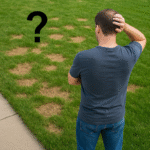 Step 1: Diagnose the Problem
Step 1: Diagnose the Problem
Water Stress or Drought?
-
Look for dry, crunchy grass.
-
Probe the soil: is it dusty and hard?
Fix: Deep water early in the morning (2–3 times per week).
Dog Urine Damage?
-
Brown center with green edges.
-
Often in small circular patches.
Fix: Rinse area heavily with water ASAP. Train dogs to use a designated spot.
Grubs or Insect Damage?
-
Lawn feels spongy underfoot.
-
You can pull up the grass easily (like lifting a carpet).
Fix: Apply a grub control treatment in late summer or early fall.
Fungal Disease?
-
Look for odd rings (“fairy rings”) or greasy-looking brown patches.
Fix: Improve air circulation, water early (not at night), and consider a fungicide if needed.
Step 2: Remove Dead Grass and Prep the Area
Once you identify the cause, it’s time to repair.
-
Rake Out Dead Grass
Remove all the dead material so healthy grass can regrow. -
Loosen the Soil
Use a garden rake or hand cultivator to loosen the top 1–2 inches of soil. -
Amend the Soil
If you’re dealing with Colorado clay, mix in compost or organic material to improve drainage and nutrients.
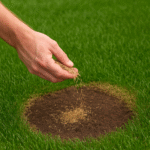
Step 3: Reseed or Patch the Lawn
Now it’s time to regrow healthy grass where the brown spots were.
Choose the Right Grass Seed for Colorado
(Important for long-term success!)
-
Kentucky Bluegrass: Great for full sun but needs more water.
-
Tall Fescue: More drought-resistant, good for Colorado front range lawns.
-
Perennial Ryegrass: Quick germination, great for high-traffic areas.
👉 Pro Tip: Use a “Colorado lawn seed blend” to match the climate and soil type.
How to Overseed Brown Spots
-
Spread Seed Evenly
Scatter the seed generously over the prepped area. -
Topdress Lightly
Sprinkle a thin layer of soil or compost over the seed. -
Water Gently and Consistently
Keep the area moist (but not soggy) until seeds germinate, usually 7–21 days depending on the variety. -
Avoid Heavy Foot Traffic
Stay off newly seeded patches as much as possible.
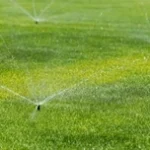 Step 4: Adjust Watering and Maintenance
Step 4: Adjust Watering and Maintenance
After your grass starts coming back, make sure brown spots don’t return by building healthy habits:
-
Water Early in the Morning
Prevents fungus and conserves water. -
Deep and Infrequent Watering
Encourages deep root growth (about 1 inch per week including rainfall). -
Mow Correctly
Never cut more than 1/3 of the grass blade height. Keep blades sharp! -
Fertilize Thoughtfully
Use a slow-release fertilizer suited for Colorado’s growing season (early spring and early fall are best times).
Bonus Tips for Colorado Lawns
Aerate Annually:
Aeration helps loosen compacted Colorado soils and improves water and nutrient absorption.
Watch for Salt Damage:
Winter road salts can seep into lawns along sidewalks and driveways. Flush these areas with water during spring.
Mulch Mow:
Instead of bagging clippings, let them break down into the soil — it adds moisture and nutrients naturally.
FAQs About Brown Spots in Colorado Lawns
Q: Should I use sod to fix brown patches instead of seed?
A: If you need an instant fix and the area is larger, sod can work well. Just make sure you prep the soil properly and water deeply.
Q: How long does it take to fix brown spots?
A: For reseeded areas, expect visible improvement in 3–4 weeks. Full recovery can take a couple of months depending on weather and grass type.
Q: Is it too late to fix brown spots in the fall?
A: Fall is actually one of the best times to repair your lawn in Colorado — cooler temps and natural rainfall help new grass thrive.
Q: Can I prevent brown spots next year?
A: Yes! Follow a seasonal maintenance schedule, aerate every spring or fall, and water smartly.
